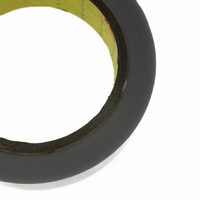9882 1 IN X 36 YD 3M, 9882 1 IN X 36 YD Datasheet - Page 3

9882 1 IN X 36 YD
Manufacturer Part Number
9882 1 IN X 36 YD
Description
THERM COND ADH 2.0MIL 1"X36YD
Manufacturer
3M
Type
Acrylic Adhesiver
Specifications of 9882 1 IN X 36 YD
Size / Dimension
1.00" W x 36 yd Roll
Lead Free Status / RoHS Status
Lead free / RoHS Compliant
Other names
3M9590
70006178910
70006178910
Technical Bulletin
System Design and Performance for 3M
I. Thermal/Mechanical
II. High/Low
Performance
Optimization
(continued)
Temperature
Performance
Depending on the thickness of the air layer, the reduction of entrapped air by using a
thicker adhesive may be enough to compensate for the increased thermal resistance
of the thicker adhesive layer. Optimized thermal performance may be found in a
trade-off between entrapped air and adhesive thickness. As a rule of thumb, the
flatness runout of both parts should be one half the thickness of the adhesive layer or
less.
Mechanical Performance
Entrapped air is detrimental to mechanical performance as well as thermal
performance; shear strength, for example, is proportional to the actual adhesive
contact area. Maximizing the contact area of the bond by minimizing entrapped air
can be beneficial for mechanical reliability during assembly as well as long term
reliability of the finished product.
In addition, incomplete contact over the bond area can affect the long term reliability
of the adhesive at high temperatures (e.g. ³ 125¡C). As discussed in Section II, an air
gap that extends to the edge of the parts, as pictured above left, will facilitate
oxidation of the adhesive at high temperatures and reduce the long term reliability of
the assembly.
Minimizing Entrapped Air
One way to determine if parts or assembly methods are likely to entrap air is to bond
the substrates individually to a glass plate with the adhesive, and then inspect the bond
area through the opposite side of the glass. Methods to reduce entrapped air include A)
cleaning parts to remove particulate contamination, B) choosing an adhesive with
thickness significantly greater than the flatness runout of the parts, C) using sufficient
assembly force to compress the adhesive and fill the gaps, D) applying force
sequentially to corners or edges rather than just to the center of the part, and E) heating
the adhesive and parts during bonding, which softens the adhesive and facilitates
Some performance considerations for use of the 3Mª Thermally Conductive Tapes
9882, 9885, and 9890 under extremes of high and low temperatures are presented
below. Data pertain to temperature extremes seen by the bonded assembly, rather
than a roll or face of the adhesive. At any temperature the bond strength is dependent
on the area bonded, which in turn requires flat, clean surfaces and assembly
conditions (temperatures, pressures, dwell times) optimized by the user to the parts
and equipment. Thermal properties have not been directly measured as a function of
environmental condition, though it is believed that wetting of the surfaces by the
adhesive and strong adhesion levels are conditions that contribute to stable thermal
properties.
High Temperatures (> 85¡C)
Short Term (Minutes)
Testing has shown excellent stability of the product in assemblies subject to
temperatures up to 260¡C (such as solder - reflow process) for several minutes.
TM
Thermally Conductive Tapes 9882, 9885, 9890
- 3 -















